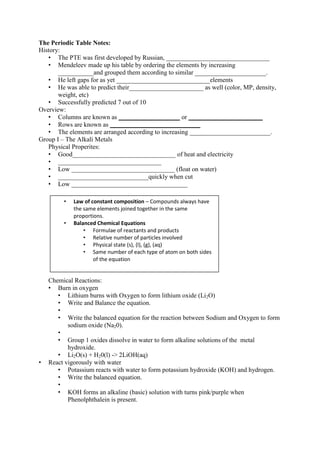
The periodic table notes
- 1. The Periodic Table Notes: History: • The PTE was first developed by Russian, ________________________________ • Mendeleev made up his table by ordering the elements by increasing ___________and grouped them according to similar ______________________. • He left gaps for as yet _____________________________elements • He was able to predict their_______________________ as well (color, MP, density, weight, etc) • Successfully predicted 7 out of 10 Overview: • Columns are known as ___________________ or _______________________ • Rows are known as ____________________________ • The elements are arranged according to increasing _________________________. Group I – The Alkali Metals Physical Properites: • Good________________________________ of heat and electricity • ________________________________ • Low ________________________________ (float on water) • ____________________________quickly when cut • Low ____________________________________ Chemical Reactions: • Burn in oxygen • Lithium burns with Oxygen to form lithium oxide (Li2O) • Write and Balance the equation. • • Write the balanced equation for the reaction between Sodium and Oxygen to form sodium oxide (Na20). • • Group 1 oxides dissolve in water to form alkaline solutions of the metal hydroxide. • Li2O(s) + H20(l) -> 2LiOH(aq) • React vigorously with water • Potassium reacts with water to form potassium hydroxide (KOH) and hydrogen. • Write the balanced equation. • • KOH forms an alkaline (basic) solution with turns pink/purple when Phenolphthalein is present. • Law of constant composition – Compounds always have the same elements joined together in the same proportions. • Balanced Chemical Equations • Formulae of reactants and products • Relative number of particles involved • Physical state (s), (l), (g), (aq) • Same number of each type of atom on both sides of the equation
- 2. • Write the balanced equation for sodium reaction with water to form sodium hydroxide (NaOH) and hydrogen gas. • React vigorously with the halogens • Sodium reacts with Chlorine to produce sodium chloride (NaCl). Write the balanced equation. • • Look at the Bohr model for sodium. What about Chlorine? Why do you think sodium reacts with chlorine so vigorously? • More reactive as you go down the group. • Reactive b/c of the lone e- in the outer shell